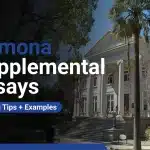Williams College’s acceptance rate sits at 8.5% for the Class 2029, reinforcing its status among the most selective liberal arts college in the country. As the #1 liberal arts college in the nation, Williams continues to draw a highly competitive applicant pool. If you’re setting your sights on this prestigious school, your application needs to stand out.
In this blog, we’ll break down what Williams College’s acceptance rate really means, how it has changed over time, and what steps you can take to improve your chances of admission. Whether you’re applying through Early Decision or Regular Decision, understanding these numbers can help you take a more strategic approach.
- What Is Williams College’s Acceptance Rate?
- Williams College Acceptance Rate Trends
- Williams College Regular Decision Acceptance Rate
- Williams College Early Action Acceptance Rate
- How to Get Accepted into Williams College
- Williams College Transfer Acceptance Rate
- Williams College Waitlist Acceptance Rate
- Frequently Asked Questions
- Takeaways
What Is Williams College’s Acceptance Rate?
The acceptance rate for Williams College’s Class of 2029 rose slightly to 8.5%, with 1,295 students admitted out of 15,225 applicants. This marks an increase from the Class of 2028, which had a record-low acceptance rate of 7.5%, admitting just 1,159 students from a larger pool of 15,411 applicants.
Here’s a closer look at the Class of 2029 numbers:
| Application Type | Total Applications | Accepted | Acceptance Rate |
| Regular Decision | 14,261 | 1,038 | 7.3% |
| Early Decision | 964 | 257 | 26.6% |
| Overall | 15,225 | 1,295 | 8.5% |
The Class of 2029 data highlights a sharp difference between Early Decision (ED) and Regular Decision (RD) acceptance rates. ED applicants were admitted at a rate of 26.6%, while RD applicants saw a much more competitive acceptance rate of just 7.3%.
Although applying ED offers significantly better odds, the admissions process remains highly selective regardless of round.
Williams College’s yield rate
Another key metric in Williams College’s admissions process is its yield rate, which represents the percentage of admitted students who choose to enroll. For the Class of 2028, Williams College had a 47.3% yield rate, with 1,159 students admitted and 548 students enrolling.
To put this into perspective, the national average yield rate for four-year colleges in 2022 was around 30%, with public colleges averaging 25% and private colleges at 33%.
Williams College’s historically high yield reflects its strong reputation and highly selective admissions process. By attracting students who are genuinely committed to joining its community, the college ensures that each incoming class is composed of driven and engaged individuals.
Williams College Acceptance Rate Trends
Williams College’s acceptance rate has been on a steady decline over the years. Here’s how the numbers, gathered from the school’s Common Data Set, have changed over time:
| Williams College Class | Total Applications | Overall Acceptance Rate |
| 2029 | 15,225 | 8.5% |
| 2028 | 15,411 | 7.5% |
| 2027 | 11,465 | 10% |
| 2026 | 15,321 | 8.5% |
| 2025 | 12,452 | 8.8% |
| 2024 | 8,475 | 15.6% |
| 2023 | 9,715 | 12.6% |
| 2022 | 9,560 | 13% |
| 2021 | 8,593 | 14.6% |
| 2020 | 6,985 | 17.6% |
Just a few years ago, Williams’s acceptance rate was well into the double digits. For the Class of 2020, nearly 18% of applicants were admitted. Fast forward to the Class of 2028, and that rate hit a historic low of 7.5%, before slightly rebounding to 8.5% for the Class of 2029.
While surging application numbers—more than doubling since the Class of 2020—are a major factor, they aren’t the whole story. Williams has intentionally kept its class size small, making admissions increasingly selective even as interest in the school grows.
The bottom line: getting into Williams is more competitive than ever. And as acceptance rates continue to tighten, academic excellence is just the starting point. Applicants hoping to stand out will need to bring not only strong grades and test scores, but also distinctive experiences, perspectives, and a compelling story that sets them apart.
Williams College’s acceptance rate vs other Ivy League schools
Williams is often considered alongside Ivy League schools when it comes to top colleges. While most Ivies haven’t shared their Class of 2029 data yet, looking at Williams’s Class of 2028 acceptance rate (7.5%) gives a good point of comparison:
|
Ivy League School |
Acceptance Rate (Class of 2028) |
|
3.6% |
|
|
3.7% |
|
|
3.85% |
|
|
4.6% |
|
|
5.2% |
|
|
5.3% |
|
|
5.4% |
|
|
8.4% |
As you can see, schools like Harvard (3.6%) and Yale (3.7%) are even more selective, while Cornell (8.4%) is slightly less so. One major reason Ivy League acceptance rates are so low is the sheer size of their applicant pools—often exceeding 50,000 applications.
Williams may receive fewer applications, but its 7.5% acceptance rate (Class of 2028) still reflects intense competition. Applications jumped from 11,465 for the Class of 2027 to 15,411 for the Class of 2028—one of the largest pools in the college’s history. With a small class size and a focus on academic excellence, Williams admits only the most exceptional students.
What makes Williams stand out is its elite yet close-knit environment. Though it has a slightly higher acceptance rate than some Ivies, the admissions bar remains incredibly high. That’s why it’s often referred to as a “Little Ivy.”
If you’re aiming for a spot at Williams, you’ll need more than strong grades. A standout application will highlight leadership, passion, intellectual curiosity, and a compelling personal story.
Williams College Regular Decision Acceptance Rate
Williams College has released its Regular Decision (RD) acceptance rate for the Class of 2029, which stands at 7.3%. Out of 14,261 RD applicants, 1,038 were admitted—marking a slight increase in selectivity compared to the previous year’s cycle (6.4%).
Why is RD typically more competitive? One key reason is Williams’s Early Decision (ED) program, which fills a substantial portion of the incoming class. For the Class of 2029, the ED acceptance rate was 26.6%, offering significantly better odds for early applicants and leaving fewer spots available during the RD round.
And the trend shows that getting in isn’t getting any easier. Just look at the numbers:
| Williams College Class | Total Regular Decision Applications | Regular Decision Acceptance Rate |
| 2029 | 14,261 | 7.3% |
| 2028 | 14,100 | 6.4% |
| 2027 | 10,522 | 8.3% |
| 2026 | 14,507 | 7.2% |
| 2025 | 11,737 | 7.3% |
| 2024 | 7,841 | 8.3% |
| 2023 | 9,026 | 10.7% |
| 2022 | 8,812 | 11.1% |
For context, the Regular Decision acceptance rate was 11.1% for the Class of 2022. By the Class of 2024, it had fallen to 8.3%, and for the Class of 2028, it dropped to a record-low 6.4%. The Class of 2029 saw a slight increase to 7.3%, but the overall trend remains clear: the RD process is becoming more competitive each year.
The driving forces behind this shift? A surge in applications and Williams’s continued commitment to keeping its class size small and selective.
So, what does this mean if you’re applying through RD? Strong grades are just the starting point. To truly stand out, you’ll need compelling essays, meaningful extracurriculars, and recommendation letters that speak to your unique strengths and potential.
Williams College Regular Decision deadline and notification date
Williams College’s RD deadline is January 1, and they usually release decisions in late March. After that, you’ve got until May 1, which is College Decision Day, to send in your confirmation.
Williams College Early Decision Acceptance Rate
Williams College has released its Early Decision (ED) stats for the Class of 2029. Out of 964 ED applicants, 257 were admitted, resulting in an acceptance rate of 26.6%.
Compared to the Regular Decision acceptance rate of 7.3%, it’s clear that applying early provides a significant advantage. Williams continues to fill a substantial portion of its incoming class through ED, favoring students who show a clear and committed interest in attending.
Let’s break down Williams College’s Early Decision acceptance rate:
| Williams College Class | Total Early Decision Applications | Early Decision Acceptance Rate |
| 2029 | 964 | 26.6% |
| 2028 | 1,311 | 19.8% |
| 2027 | 943 | 27% |
| 2026 | 814 | 31.2% |
| 2025 | 715 | 33.3% |
| 2024 | 634 | 39.3% |
| 2023 | 689 | 37.3% |
| 2022 | 748 | 34.5% |
Williams College’s Early Decision (ED) acceptance rate has fluctuated over the past several years, but the broader trend shows a decline—from 39.3% for the Class of 2024 to just 19.8% for the Class of 2028. The Class of 2029 saw a small rebound to 26.6%, though that came with a notable drop in the number of ED applicants (964, down from 1,311 the year before). As ED continues to attract top-tier applicants and fill a large share of each incoming class, the process remains highly competitive.
That said, applying early still offers a clear advantage. ED acceptance rates are consistently higher than Regular Decision (7.3% for the Class of 2029), particularly for students who demonstrate strong interest and present a compelling, well-rounded application. But make no mistake: the ED pool is full of outstanding candidates, so stellar academics alone won’t guarantee admission.
It’s also worth remembering: Williams’s ED program is binding. If admitted, you’re committing to attend, so it’s best for students who are confident that Williams is their top choice. That level of commitment can work in your favor—admissions officers know you’re all in.
Another benefit? You’ll hear back months before RD applicants, giving you more time to plan your next steps. Just be sure your application is truly ready—rushing to apply early with a weaker file can backfire. If you need more time to present your best self, waiting for RD may be the better move.
Williams College Early Action deadline and notification date
Williams College’s ED deadline is November 15, and they typically send out notifications by mid-December. If you’re accepted, you still have until May 1 to confirm your spot.
How to Get Accepted into Williams College
So, you’re aiming for a spot at Williams College? The first step is submitting your application through either the Common Application or the Coalition Application.
Williams College takes a holistic approach to admissions, evaluating more than just grades and test scores. The committee looks for thoughtful essays, meaningful extracurriculars, and recommendation letters that provide real insight into who you are beyond the numbers.
Let’s dive into the key factors that can help you stand out and boost your chances of admission:
Target GPA
Williams College doesn’t set a minimum GPA requirement, but make no mistake—you’ll be competing with some of the strongest students.
The average GPA for admitted students is 4.07, reflecting the high academic standards at Williams. This means successful applicants aren’t just excelling in their coursework; they’re also challenging themselves with AP, IB, or other advanced courses to boost their GPAs beyond a 4.0.
While a 4.07 GPA is typical for accepted students, don’t be discouraged if your GPA is slightly lower. Williams takes a holistic approach to admissions, considering your entire academic and extracurricular profile. If your GPA isn’t at the top of the scale, strong essays, leadership experience, and unique achievements can still help you stand out.
Target test scores
Williams College takes a test-optional approach, meaning SAT and ACT scores are not required for admission. However, if you choose to submit them, strong scores can provide an additional advantage by showcasing your academic abilities in a standardized format.
While there’s no minimum SAT and ACT score requirement, admitted students tend to have highly competitive scores. Based on Williams’s 2023-2024 Common Data Set, here’s a look at the SAT and ACT score range for successful applicants:
| Standardized Test | 25th Percentile Score | 50th Percentile Score | 75th Percentile Score |
| SAT | 1480 | 1520 | 1550 |
| ACT | 33 | 34 | 35 |
These figures highlight the high academic caliber of Williams’ admitted students. Scoring at or above the 75th percentile (1550 SAT or 35 ACT) places you among the most competitive applicants. Meanwhile, scoring at the 25th percentile (1480 SAT or 33 ACT) means your test scores are still strong but should be complemented by exceptional essays, extracurriculars, and recommendations.
While these statistics provide a benchmark, Williams takes a holistic approach to admissions, meaning your GPA, personal achievements, and overall application strength carry significant weight.
Other requirements
Williams College takes a holistic approach to admissions, meaning your grades and test scores are just one part of the equation. Your extracurricular activities, essays, and recommendation letters all play a crucial role in showing the admissions committee who you are beyond academics.
- Letters of recommendation. Williams requires three recommendation letters: two from teachers who taught you in core academic subjects (e.g., math, science, English, history, or foreign language) and one from your counselor. Choose teachers who can speak to your academic abilities, work ethic, and personal growth.
- Essays. Williams College does not require a personal essay. However, you may supplement your application by writing a 3-5 page academic paper written in a previous year. The paper may be creative or analytical, can cover any topic, and need not be graded. Make sure to include a description of the assignment or prompt and do not submit lab reports.
- Extracurricular activities. Williams College values activities that highlight leadership, passion, and meaningful contributions. Programs like the Yale Young Global Scholars and Scholastic Art and Writing Competition can showcase these qualities. Focusing on impactful experiences like these can help your application stand out.
For a complete overview of each section, check out our guide on getting into Williams College. It breaks down the requirements step by step and offers tips to help you build a compelling, well-rounded application that highlights your strengths and boosts your chances of acceptance.
Williams College Transfer Acceptance Rate
According to its 2024-2025 Common Data Set (Class of 2028), Williams College’s transfer acceptance rate is just 2.8%. Out of 543 applicants, only 15 were admitted, and just 6 ultimately enrolled.
So, why is transferring to Williams College so challenging? A big reason is the limited availability of spots. With the majority of seats already filled by incoming freshmen, there are only a few openings left for transfer students, making the process highly competitive.
Williams College transfer requirements
Williams College’s transfer admissions process is highly selective, focusing on academic performance and fit. Unlike first-year admissions, which consider a broad range of factors, Williams looks for transfer students with strong academic records and a clear, compelling reason for making the move.
To apply, transfer students must submit the Common Application, which includes one required essay, along with a final high school transcript or high school equivalency diploma, a Transfer College Report, a college transcript, and two recommendations from college instructors. There is no application fee.
If applying for financial aid, students can request a fee waiver for the CSS Profile. The admissions process is need-blind, meaning financial circumstances will not affect the decision.
With so few spots available, strong grades alone won’t guarantee admission. Successful applicants demonstrate a clear academic purpose, the ability to excel in Williams’ rigorous environment, and experiences that will enrich the campus community. Given the extremely low acceptance rate, a well-prepared and compelling application is essential.
Williams College Waitlist Acceptance Rate
Williams College’s waitlist acceptance rate is tight. For the Class of 2028, out of 2,308 students who were waitlisted, 858 opted to remain on the waitlist, but only 113 were eventually accepted. This resulted in a waitlist acceptance rate of just 13.2%.
What to do if you’re waitlisted
Landing on Williams College’s waitlist can be frustrating, especially given the low admission rate for waitlisted students. While the chances are slim, there are still steps you can take to stay in the running:
- First, submit the Respond to Waiting List Offer form by May 1. This confirms your interest in staying on the waitlist. After that, you can also submit the Continued Interest form to keep Williams updated on your latest accomplishments.
- Avoid sending extra recommendation letters. Your application is already well-documented, and Williams does not require additional recommendations. However, if you have significant updates—like higher test scores or new academic achievements—you may submit them.
- Don’t rely on just one strategy. While it’s okay to stay hopeful, be realistic. Make sure you have a backup plan and secure a spot at another school where you’ve been accepted. The waitlist process is unpredictable, so having a solid alternative is essential.
- Know that financial aid won’t impact your chances. Williams remains need-blind for U.S. citizens, permanent residents, and DACA-designated applicants. If admitted, you’ll receive a financial aid package and have time to review it before making a final decision.
- Taking a gap year is an option. If admitted from the waitlist, your gap year request will likely be approved if you decide to defer enrollment.
- If you want to remove yourself from the waitlist, let Williams know as soon as possible. This helps them manage their admissions decisions and ensures spots are offered to students who remain interested.
While the odds of admission from the waitlist are low, staying proactive while keeping realistic expectations is the best approach.
Frequently Asked Questions
1. What is Williams College’s latest overall acceptance rate?
For the Class of 2029, Williams College had an overall acceptance rate of 8.5%, admitting 1,295 students out of 15,225 applicants. This marks a slight increase from the record-low 7.5% for the Class of 2028, but still reflects the college’s highly selective admissions process.
2. What is Williams College’s Early Action acceptance rate?
For the Class of 2029, Williams admitted 257 students out of 964 Early Decision applicants, resulting in an ED acceptance rate of 26.6%. This is significantly higher than the Regular Decision rate, continuing the trend of ED applicants having a strategic advantage.
3. What is Williams College’s Regular Decision acceptance rate?
For the Class of 2029, the RD acceptance rate was 7.3%, with 1,038 students admitted from a pool of 14,261 applicants. While slightly higher than last year’s 6.4%, the RD round remains intensely competitive due to the limited spots available after ED offers.
4. What is Williams College’s transfer acceptance rate?
Williams College’s transfer process is highly competitive, with a transfer acceptance rate of just 2.8% for the Class of 2028. Out of 543 applicants, only 15 were admitted. Given the limited number of spots, only applicants with strong academic records and compelling reasons for transferring are accepted.
5. What is Williams College’s waitlist acceptance rate?
For the Class of 2028, 2,308 students were offered a spot on the waitlist, and 858 chose to stay on it. Of those, only 113 were ultimately admitted, resulting in a waitlist acceptance rate of approximately 13.2%.
Takeaways
To really get a grip on the Williams College acceptance rate and raise your chances, here are some key things you should know:
- Williams College’s latest overall acceptance rate is 8.5%.
- Applying Early Decision gives you a major advantage. For the Class of 2029, the ED acceptance rate was 26.6%, compared to just 7.3% for Regular Decision.
- Strong academics are crucial, but they’re not everything. The average admitted GPA is 4.07, and competitive applicants score between 1480-1550 on the SAT or 33-35 on the ACT. However, essays, extracurriculars, and recommendations play a huge role in standing out.
- With such a competitive acceptance rate, seeking guidance from a college admissions consultant could help strengthen your Williams College application and improve your chances of standing out.

Eric Eng
About the author
Eric Eng, the Founder and CEO of AdmissionSight, graduated with a BA from Princeton University and has one of the highest track records in the industry of placing students into Ivy League schools and top 10 universities. He has been featured on the US News & World Report for his insights on college admissions.










